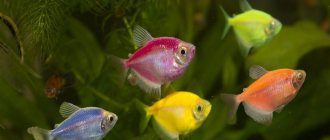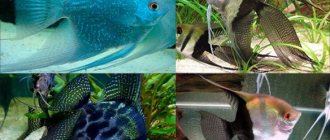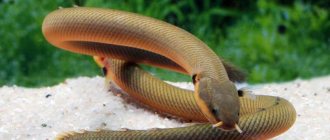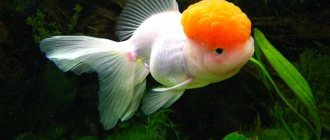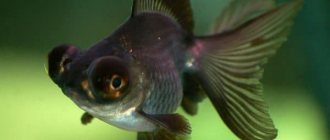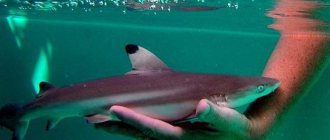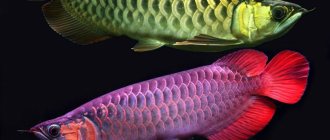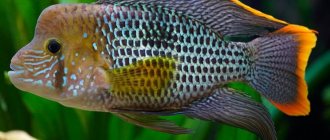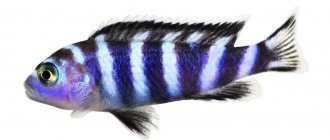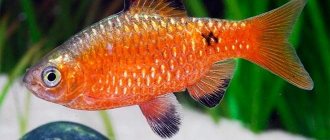Motherland
The labeo fish (family Cyprinidae) is found in Southeast Asia. Habitats are small streams, lakes and rivers with strong currents, densely overgrown with vegetation. Under natural conditions, the size of the labeo reaches 30 cm. The fish was first discovered in the floodplain of the Chaopraya River in the Kingdom of Thailand, in 1952 it was brought to Europe, and in 1957 it appeared among Soviet aquarists. Later, species were discovered living in Africa, where they are natural orderlies.
Labeos are omnivores, but prefer plant foods. During spawning (coinciding with the rainy season), the fish makes long migrations. Land drainage and dam construction have disrupted the labeo's life cycle, significantly reducing its population.
Appearance
The aquarium fish Labeo has an elongated torpedo-shaped body, a slightly arched back with a high “shark” fin, and a two-lobed tail. The head is small, the eyes are large. The oral apparatus has the shape of a scraper; there are two pairs of small whiskers around the mouth. In aquarium conditions, fish do not grow more than 12-15 cm. Females are somewhat larger than males, whose color is more intense.
There are 5 species in aquariums, the most famous is the bicolor labeo with a black velvety body color and a scarlet forked tail.
Types of labeo suitable for keeping in aquarium conditions:
Green (Congolese).
Albino Labeo.
Labeo black.
Labeo harlequin.
Young fish stay in groups; adults prefer solitude, meeting only for spawning.
Appearance of Thai fish
As you know, fish with extravagant colors are the first to attract attention in an aquarium; in fact, Labeo’s colors are very bright and attractive. They have a velvety black, matte body and a bright scarlet tail . Thanks to its clearly defined lines and elongated shape, the body of the fish is similar to a shark; in English, Labeo is called “red tail shark”.
Due to their bright appearance and increased activity, it is almost impossible not to notice these fish even in a large aquarium. Among labeos there are also albino individuals. However, they are not bicolors, but are a subspecies of green labeo. They completely lack black pigment, and their fins and eyes are red. In other respects, albinos are in no way inferior to their counterparts, except that they are considered to be more peaceful creatures.
In general, Labeo are quite large representatives of the aquarium world. In nature, the average size of fish is 18–20 cm, although there are also giants 28–30 cm in size. Living in an artificial, limited environment has led to the smaller size of the species. However, even 10-12 cm labeos, in comparison with many inhabitants of the aquarium, look very impressive. On average, fish of this species live 5-6 years, but there are a number of confirmed facts that among labeo there are long-livers - 9-10 years of age.
Care and maintenance
For comfortable living, Labeo requires aquariums with a volume of at least 120 liters. The optimal parameters of aquarium water are presented in the table.
| View | Volume of water per 1 individual | Temperature | Acidity | Rigidity |
| Aquarium labeo | 60 l | 23-27˚С | pH 6.5-7.5 | GH 6-18 |
Under natural conditions, fish live in rivers and streams with strong currents. When kept in an aquarium, labeos need powerful filtration and aeration - the water must be saturated with oxygen.
Fish do not tolerate excess organic matter well and are demanding of fresh water. 20% of the aquarium water should be replaced with fresh water weekly. It is recommended to simulate conditions close to the natural habitat. Labeo prefer moderate diffused lighting, an aquarium with an open space near the front glass, densely planted with plants in the background. Algae should be selected with a strong root system that can cling to snags and stones and wide leaves that create shading.
Aquarium soil is preferably dark: pebbles, round stones, sand. Stones should not contain sharp corners. Labeo, which swims quickly in the lower layers of water, can get injured.
The fish does not tolerate excess ammonia, nitrates and nitrites in aquarium water. Tetra EasyBalance neutralizes phosphates and reduces the content of nitrogen compounds.
Labeo spends most of its time in open space. Needs a shelter where in case of danger it can hide. The aquarium must have a lid - nimble labeos can jump out of the water.
The fish is unpretentious in nutrition. Can eat live food, scraped greens (spinach, zucchini, lettuce), and oatmeal. In between feedings, he scrapes algae deposits from aquarium glasses.
Sinking granules are what you need for bottom dwellers such as labeo.
When buying balanced dry store food or chips, you should give preference to sinking food with a high fiber content (TetraPro Algae). The fish are fed twice a day. The feeding rate is calculated as follows: the food that has fallen to the bottom must be eaten within 5 minutes. If this does not happen, the portion is reduced.
Content
Since the fish are accustomed to sharing the area, you will need a large aquarium - from a hundred liters per fish. It is imperative to have shelters and places where the fish can rest. Branched and large-leafed plants with a strong root system, stones, driftwood and their intertwining, decorative elements made of clay, coconut shells, etc. are suitable. This can be used to divide the aquarium into zones, creating secluded corners, small caves and grottoes. Based on the huge number of necessary decorations, the volume per individual can increase to 150 liters.
You will also need to purchase a lid for the aquarium. Labeo are nimble fish and can jump out of the water.
As a soil, a universal option is usually chosen - small pebbles or sand of medium and coarse fractions. It is important that the soil does not have sharp corners, because fish can get hurt on them when they eat algal growths on it.
To keep Labeo comfortable, you will need to create a clean and transparent environment. Therefore, you should purchase a powerful filter and compressor to saturate the water with oxygen.
In addition, the following parameters must be observed:
- Temperature is about 23-27 degrees Celsius;
- Hardness from 5 to 15°;
- Acidity is about 6.5-7.5 pH.
Every week it is necessary to change a third of the water to fresh water and clean the aquarium. Also, fish do not require special lighting. They will have enough light that is needed for the development of flora in the aquarium.
This aquarium fish is not picky about food. She can eat dry, live and frozen food, scalded vegetables and herbs, and oatmeal. You can put glass in the aquarium as a supplement. The algae with which it grows is a delicacy for them. Feeding is carried out twice a day. The serving size can be determined by how long it takes the fish to eat all the food. If after a couple of minutes the food remains on the surface of the water (or at the bottom), the remains should be removed immediately and the portion reduced next time.
Compatibility
Labeo Thai is a zonal fish that clearly knows the boundaries of its territory. Juveniles are shy and hide among plants most of the time. As the fish ages, it becomes more aggressive. Labeos do not get along well with their relatives. To avoid fights when keeping several fish, you need to reduce contact to a minimum by dividing the aquarium into zones using driftwood or decorations. Any fish injured as a result of the conflict should be removed until it has fully recovered.
Compatibility can be achieved by breeding more than four labeos in a large aquarium, to reduce concentration on a specific fish and build hierarchical relationships. Usually the strongest individual dominates the others. The alpha male swims throughout the aquarium, but does not allow strangers to enter his territory.
The compatibility table clearly demonstrates with whom Labeo gets along best.
Poor compatibility forces you to carefully select fish to keep together. Labeos often bully individuals with red or black coloring, mistaking them for their competitors. It is better not to keep bettas, goldfish, cichlids and catfish in the same aquarium with them.
Labeo bicolor calmly relates to small schooling fish that live in the upper layers of water: zebrafish, neon, barbs, gourami.
Conditions and care
When deciding to keep a Labeo fish, for example a two-colored one, the aquarist must know what conditions will need to be provided for the optimal development of such a fish.
Feed
Let us immediately note that the fish under discussion are undemanding when it comes to nutrition. The diet can include both plant and living foods. Store-bought dry food is also suitable. Labeos eat tubifex, bloodworms and daphnia. Salad leaves scalded with boiling water, pieces of zucchini or cucumber, and oatmeal are also a great addition to diversify the diet. Egg yolk and fish paste can also be used as top dressing.
Gammarus is often used as food for fish. Find out in detail how to collect it, prepare it, store it and give it to the fish.
From time to time it is worth placing a sheet of glass that has become overgrown with algae into the aquarium. Labeos will happily eat it, since their oral apparatus allows such manipulations. If the choice falls on dry food from specialized stores, then it is better to choose one that will sink in water. The fact is that Labeo’s mouthparts are located in such a way that they can only take food from some surface or from the bottom.
Experienced aquarists recommend feeding the fish in question twice a day. If you provide small pets with appropriate care and optimal food, these beauties can live up to 8–12 years.
Compatibility with other fish
No less important is information about the compatibility of Labeo bicolor with other inhabitants of the aquatic world. Note that adult fish have a very dominant and even, in a sense, warlike character. This is especially noticeable in males. They not only do not allow other fish into their territory, but even allow themselves to violate the territory of their neighbors. It is in order to prevent such conflicts that one must always take into account the character traits of these fish and their neighbors.
Labeo will definitely not like cichlids and large fish that have a similar color. They love their relatives only during the spawning period, but permanent proximity will not suit them.
If possible, it is best to arrange the aquarium in such a way that Labeo coexists with loaches, tetras, gouramis, angelfish or barbs. Such fish are not aggressive, and also prefer to be located in the upper layers of the water, which will allow them to meet Labeo less often. Plus, they are very agile and fast, which means they are almost elusive for Labeo.
Did you know? The smallest fish is considered to be the dwarf goby. It lives in the Indo-Pacific region. The body length of females reaches no more than 9 millimeters, and males can be even smaller.
Interior of the underwater kingdom
For the fish species in question, you will need a large, wide aquarium, the volume of which should be at least 150 liters. If you plan to keep a group of individuals, then you need to allocate about 50 liters of water for each of them.
The water should be warm, the optimal temperature is 24–27 °C. It is best if it is peat. This property can be achieved by placing a nylon bag next to or inside the filter, into which fresh peat is placed in advance. This homemade peat block needs to be changed every 2-3 weeks. It is very important to ensure good aeration of the water space, as well as change up to 20% of the water every 7 days.
Find out how to set up an aquarium - choose a filter, soil, maintain temperature, regulate water quality, choose plants for the aquarium, set a background, get rid of diatoms and planaria.
As for lighting, it should be moderate, not bright. In this regard, the algal fouling that the fish will feed on will need to be grown in a separate aquarium, which is better lit. Such an aquarium can be placed, for example, on a well-lit, sunny windowsill.
If there is no possibility of differentiation, then you can provide the main aquarium with bright light so that algae can grow in full force, but the bottom will need to be shaded using plants with large leaves or grottoes where the fish can hide.
Diseases
The bicolor labeo is an aquarium fish with high immunity. The main reason for her poor health is errors in care. The fish does not tolerate long-term stress that arises due to disturbances in maintenance:
- at low water temperatures;
- low compressor power;
- poor quality nutrition.
The labeo appears depressed, its color turns pale, and its appetite disappears. The fish react negatively to the movement of their shelter during cleaning. When populating the aquarium, the labeos are introduced first, allowed to get comfortable, then the rest of the fish are placed.
04:19
LABEO. MAINTENANCE, CARE, FEEDING, REPRODUCTION, COMPATIBILITY.
05:01
Labeo bicolor in an aquarium. Compatibility, maintenance, reproduction. Albino.
04:34
LABEO IS A TERRITORIAL ALGAE EATER. CONTENT IN THE AQUARIUM
Diseases that may appear during aquarium keeping:
- ichthyophthyriosis is a highly contagious disease, manifested by the appearance of white spots on the body and fins, and exhaustion;
- dropsy (carp rubella) - there is bloating, redness of the abdomen, ulcerations, loss of appetite;
- mucous skin - manifests itself as a whitish coating on the body, occurs with a bacterial or parasitic infection.
Sick fish are placed in quarantine and treated in a saline solution (1 tbsp per 10 liters of water). For dropsy, antimicrobial drugs are added to the feed.
Early diagnosis of diseases increases the chances of recovery.
Reproduction
Aquarium labeos are difficult to distinguish by gender; the female has a slightly more rounded abdomen. In juveniles, it is impossible to distinguish males from females. The fish reach sexual maturity at the age of 1.5-2 years.
How to easily determine the sex of a labeo? Pay attention to the dorsal and anal fins; their shape is curved in males and straight in females.
Natural spawning in aquarium conditions occurs extremely rarely. To stimulate sexual activity, professionals purchase hormonal gonatropic injections from fish farms, which are injected into the back muscles of males and females. In stores you can buy the non-hormonal drug "Nerestin" in the form of injections or additives to animal feed. The drug is given 2 times at intervals of a day.
Before spawning, the spawners are seated, the water temperature is reduced to 23-24˚C, fresh water is added every other day, and they are fed abundantly and variedly for 10-14 days. Prepare the spawning ground: an aquarium with a volume of at least 150 liters, a water level of 40 cm. The container should be equipped with a compressor and a filter, densely planted with plants, and equipped with dim lighting. A female and 2-3 males are placed in the aquarium. After administration of the drugs, spawning begins after 5-6 hours. If the female does not begin to spawn, reduce the water hardness.
It is prohibited to reduce the water temperature in the aquarium below 24-26˚C after the introduction of hormones; the fish may die.
Spawning lasts about half an hour, during which time the female spawns about 1000 eggs. Some of them swim in the water column, others sink to the bottom and are eaten by fish. Unfertilized eggs turn white within 2 hours, they are removed from the aquarium, and the spawners are removed. The eggs are transferred to a small container (up to 20 liters) with light aeration.
04:06
Labeo breeding. Part 1
07:25
Labeo breeding. Part 2
04:19
LABEO. MAINTENANCE, CARE, FEEDING, REPRODUCTION, COMPATIBILITY.
Caviar matures in 14-16 hours. After the embryos hatch, the water becomes cloudy and the litter may die. Frequent water changes can help save the situation. After 1-2 days, fry appear, capable of moving and feeding on ciliates. After a few days, egg yolk and brine shrimp eggs are introduced into the diet. The first two weeks are the most difficult - during this time up to half of the litter dies. The surviving fry grow unevenly.
Another reason for the difficulty of breeding black fish with a red tail is the lack of males. Initially there are few of them in the litter; during the process of growth, larger females slaughter weaker male juveniles. The solution is to remove fish with stunted growth.
Reproduction under artificial conditions
Obtaining labeo offspring in a regular aquarium is an extremely difficult task. As a rule, fish of this breed are bred either on Southeast Asian farms or by experienced aquarists with suitable equipment.
The main difficulty is that for breeding labeo it is necessary to use gonadotropic hormones that stimulate spawning. And if you make a mistake with the dosage of drugs, the fish will die. Another problem is that the brood of fish consists mainly of females, while there are catastrophically few males. To get a male, you will need to breed a large number of young animals. And young fish do not have any sexual differences, and it is unclear whether they have a pair or not.
But professionals in their field do not give in to difficulties, which is why labeos periodically appear on sale, obtained by local aquarists. To breed labeo, you will need impressive tanks of 500 liters or more. Spawning should involve two males and one female.
Before mating and fertilization, individuals must be kept separately and fed with live food, frozen spinach leaves and scalded lettuce. The process then proceeds according to the following program:
- hormones are injected into the back of individuals;
- the fish must be left for 3-4 hours;
- Spawning can only be expected after 5-6 hours;
- the female produces about 1000 eggs - some will settle to the bottom and will be eaten by the parents themselves, and everything that floats will remain untouched;
- when the spawning process is completed, the spawners should be isolated and the eggs sorted - the pale ones are removed, and the good ones are sent to a 20-liter special room filled with water in which the spawning took place;
- aeration is necessary, but it is made weak;
- it is necessary to wait an incubation period of 12 hours;
- a day after spawning, the eggs will begin to hatch into fry - small, but independent, able to swim and eat;
- young animals eat live dust, rotifers and algae covering the walls of the aquarium;
- in the first two weeks, about half of the fry die, leaving the strongest fish, which will continue to live in the aquarium without any problems.
Reviews
A two-color labeo appeared in my aquarium and soon became my friend. At first, his behavior bothered me: he could lie on the bottom with his belly up or freeze vertically in the water column. I thought he was sick and would soon die, but the fish did not lose his appetite, it turned out that this was natural swimming for him. Ekaterina, 37 years old, Moscow
When I put my hand into the aquarium, the inquisitive labeo is right there. He gently pinches my hand, lightly tickling me with his antennae. The fish is very emotional: as soon as I bring my hand closer to the snag that he has chosen for his shelter, he suddenly turns pale, it seems that the fish is about to faint. It is very interesting to watch an aquarium labeo: judging by its behavior, the fish’s intelligence is quite high, it strictly controls the boundaries of its territory. Valentin Samoilov, 60 years old, Yaroslavl region.
Before getting an aquarium labeo, I read the literature and purchased a ceramic decoration in the form of an amphora with an entrance and exit. The fish immediately made it its refuge. You can often watch her swim in and out of hiding. Labeo is fast and nimble, makes rapid throws. Unpretentious in nutrition, willingly eats not only plant foods, but also bloodworms and tubifex.Juli88
My big mistake was introducing a pair of veiltails into a common aquarium. Although they were not red, for some reason my two-color labeo actively did not like them. After a couple of hours, the goldfish, with their fins badly torn, had to be urgently transplanted. In relation to other aquarium inhabitants, including snails, my Labeo is quite peaceful. Aquarist20_10
Behavior and Compatibility
Territorial, a group always has a leader who is capable of not only defending his own territory, but also swimming into someone else’s. It is better to keep them alone, but for a flock you need a very spacious aquarium and a large number of shelters, which will prevent interspecific conflicts.
It is not recommended to keep it with fish that are similar in color.
Mistaking them for representatives of its own species, the Labeo will show aggression. Compatible with active, but not aggressive species: zebrafish, gouramis, angelfish, loaches, large tetras, barbs. Ideally, it should be the last addition to the aquarium so that it does not claim ownership of the entire space.
